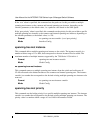
User Manual for the NETGEAR 7300 Series Layer 3 Managed Switch Software
8-88 Switching Commands
202-10009-01_060204
If the ‘cost’ token is specified, this command sets the path cost for this port within a multiple
spanning tree instance or the common and internal spanning tree instance, depending on the
<mstid> parameter, to the default value, i.e. a pathcost value based on the Link Speed.
If the ‘port-priority’ token is specified, this command sets the priority for this port within a specific
multiple spanning tree instance or the common and internal spanning tree instance, depending on
the <mstid> parameter, to the default value, i.e. 128.
Format no spanning-tree mst <mstid> {cost | port-priority}
Mode Interface Config
spanning-tree mst instance
This command adds a multiple spanning tree instance to the switch. The instance <mstid> is a
number within a range of 1 to 4094, that corresponds to the new instance ID to be added. The
maximum number of multiple instances supported by the 7300 Series L3 Switch is 4.
Format spanning-tree mst instance <mstid>
Mode Global Config
no spanning-tree mst instance
This command removes a multiple spanning tree instance from the switch and reallocates all
VLANs allocated to the deleted instance to the common and internal spanning tree. The instance
<mstid> is a number that corresponds to the desired existing multiple spanning tree instance to be
removed.
Format no spanning-tree mst instance <mstid>
Mode Global Config
spanning-tree mst priority
This command sets the bridge priority for a specific multiple spanning tree instance. The instance
<mstid> is a number that corresponds to the desired existing multiple spanning tree instance. The
priority value is a number within a range of 0 to 61440 in increments of 4096.


















